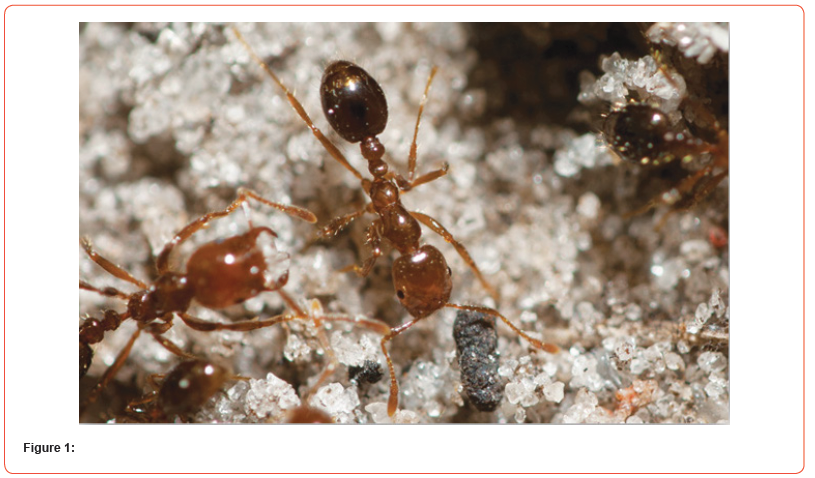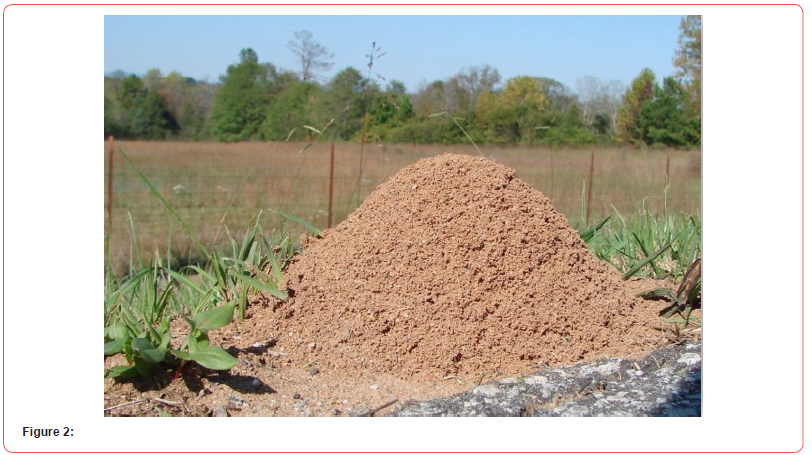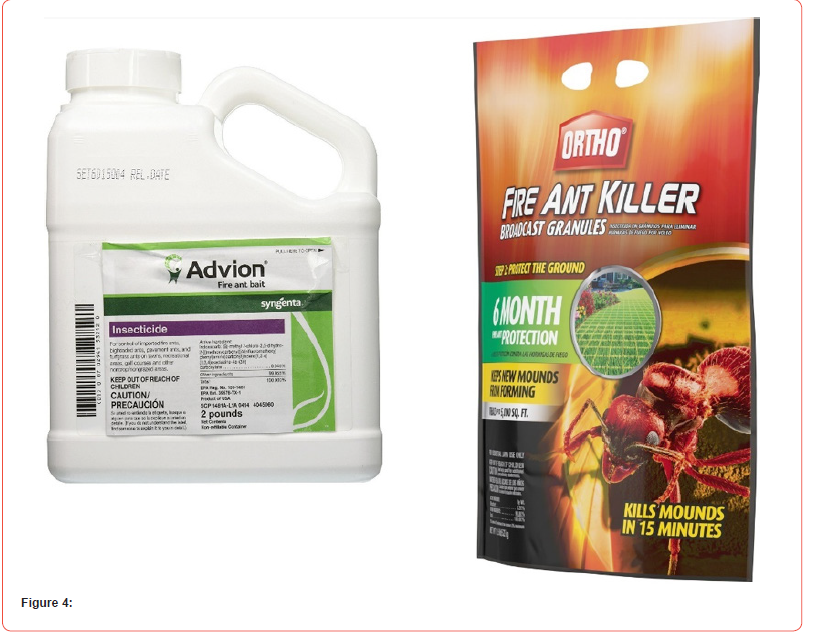 Mini Review
Mini Review
Red Imported Fire Ants
Nathan Hermond*
Extension Associate, College of Agriculture and Human Sciences, Prairie View A&M University, USA.
Corresponding AuthorNathan Hermond, Extension Associate, College of Agriculture and Human Sciences, Prairie View A&M University, USA.
Received Date:July 24, 2023; Published Date:August 21, 2023
Introduction
Solenopsis invicta known as the Red Imported Fire Ant functions, as one of the worst invasive species to plague the southeastern United States. The features that allow invasive species to take over an area and stifle management practices include ease of spread, rapid reproduction, aggressiveness and lack of sufficient natural predators. Invasive species also tend to compete with and wipe out native species that contribute to natural ecology. All these features describe fire ants perfectly. Many invasive species, much like fire ants, are transported because of human error or introduction via equipment and gear, allowing the species to travel unnoticed into an inappropriate ecosystem.

The Red Imported Fire Ant is a bright red to rust red hue, with a darker brown to black abdomen. Individual insects’ range in size from 1/8 to 3/8 of an inch. Their antennae, much like native ant species, are elbowed. Fire ant waists are knobbed with two petioles (knots). The ants are covered in short sparse hairs and are significantly shinier than ants such as Crazy or Harvester ants. There are 2 or 3 lighter colored bands on the lower abdomen. Fire ants are primarily restricted to the southeastern United States, ranging from Maryland to Texas, although they do reach California and New Mexico (pestworld.org). Red Imported Fire Ants are native to South America and were transported to the U.S. via ships.
What makes Red Imported Fire Ants such major pests? These ants are eusocial like other members in the order Hymenoptera, which includes yellow jackets, paper wasps and honeybees. Because of this social lifestyle, fire ants appear in large numbers. A single nest can contain 500,000 worker ants, according to Orkin, the pest control company. As ants build their underground tunnels and expand their nests, they create new mounds and entrance holes. Additionally, once new drones and queens (from unfertilized eggs) have mated, the queens seek their own territory and produce a new nest, laying fertilized eggs that produce female worker ants. This means that multiple nests are related to one another, resulting in increasing numbers of nests in a single area, be that yards, roadsides or open fields where livestock graze. While new nests will compete with one another, they primarily hunt down and eliminate native species such as the Red Harvester Ants. Elimination of native species by the rapidly growing number of fire ants’ results in an unbalanced environment, as each species has a role. Harvester ants are gatherers that feed on seeds and fruits as well as other insects, including agricultural and urban pests. Fire ant nests are built in close proximity to humans and their farms, gardens, livestock and pets. This means that a confrontation is inevitable. Fire ants produce formic acid which is used in their sting and causes the painful burning sensation that gives them their moniker. This sting results in painful welts and allergic reactions that produce swelling. Anaphylactic shock and death can occur in children, the elderly and allergic individuals. Fire ants also construct their nests in electrical and farm equipment, causing shortages and technological failures.

Fire ants are a significant problem for farmers, ranchers, urban gardeners, schools and homeowners. Mounds, hidden among tall grasses and weeds, cover large swaths of territory. Farmers and livestock may be unaware of these nests, and tread through them, resulting in unexpected pain. Urban gardeners have to deal with fire ant mounds built around their homes, in crevices near plant beds, around trees and even in weep holes through which these pests invade homes and seek out sweet and salty human foods. The mounds are also hidden within turf, making maintenance a painful experience for homeowners and golf green owners. Land around schools and playgrounds are prime territory for ants to build large mounds, and if children are either unfamiliar with fire ants, or unable to see their hidden nests, painful bites may result. This is made worse by allergies and the pheromones that ants release to call in reinforcements, which is why people who experience fire ant attacks are almost never bitten by just one or two, but in numbers ranging from 20 or 30 up to several hundred at a time. Additionally, fire ants are likely to invade homes and reside in kitchen cabinets and cupboards. Even well closed containers are violated by worker ants.

Life Cycle
The life cycle of these determined pests must be observed and understood, so that homeowners, farmers/ranchers, and the entomologists who aid them will utilize proper management and recognize the features that enable ants to successfully terrorize homes, gardens, farms and wild ecosystems. Fire ant reproduction has two stages, one for individual ants and one for the colony as a whole. Individual ants, like their wasp and bee cousins, are holometabolous (reproduce by complete metamorphosis). Holometabolous insects go through a cycle of eggs, larvae, pupae, and adults. In Hymenopterans, the larval form is called a grub. Eggs typically hatch in a week after they are laid by the queen. These grubs are fed by the queen at first, then by the workers, once a small population is established. Most Hymenopteran grubs feed on captured prey, although sugary substances like nectar and honeydew are also utilized. Molting occurs between life stages and allows grubs to progress through the instars until becoming large enough for the final molt into their pupal form. Once the adult ant emerges from the pupal casing, the work of maintaining the hive and gathering food for fellow ants begins.
The life cycle of a hive is unique to eusocial insects, as it depends on many individuals. Hives continue to grow in size, and as this occurs, winged reproductive ants are produced during Spring. Drones and future queen ants are produced from unfertilized eggs with a haploid gene, while workers are produced from fertilized eggs and possess a diploid gene. As these winged males and females take to the sky, they mate. The male drones die, while the female ants go in search of an area to build their new empire. The fire ant queen’s preference for a new nest is bare loose soil or areas hidden in tall grasses, safe from predators and enemy ants. The queen lays fertilized eggs to start her nest and feeds them herself after they hatch in 10 days. Once these newborns become adults within the span of a month, they forage and tend to the queen. The queen fire ant is an egg laying factory, and she lays up to 1500 eggs per day. As such, the hive quickly grows, and the ants develop tunnels used for specific purposes, including tending to the queen and storing their food. Hives are designed to regulate temperature and are an inspiration for human construction such as skyscrapers and homes. Fire ant hives can host multiple queens, although this may cause conflict. Fire ants must accept a new queen, and if a queen is considered weak or old, she is executed and disposed of. Once a hive is fully operational, the ants will share a pheromone that visitors must possess. Any ant that dares enter the nest will be checked for this telltale scent, and killed by powerful guards if it is found to be unacceptable. Additionally, foraging ants cut down and eliminate any insects they come across to feed to their nest. Workers live for just over a month, while queens can live for up to 7 years.
Fire Ant Management
When beginning a management plan for pests such as fire ants, one must keep in mind the impact chemicals may have on the environment, their pets and children. As such there are several paths to eliminating ants and reducing their presence on farms, in gardens, and around homes.
The traditional methods of dealing with fire ants rely on pesticides, Store bought pesticides may function well, with a few specific selections being the most successful and quickest to act. Boric acid dusts are a fast-acting dry material that can be used in homes and then cleaned away once the ants have died off. These dusts are perfect for reaching the queen and the ants that remain hidden in the hive. Once it is applied to a nest, ants that enter and exit will transfer the dust to other workers, and eventually to the queen. A single application is usually successful, though a second may be beneficial for a larger mound, especially in gardens and other outdoor environments.

There are a variety of dry pellets and grains, such as Triazicide, that ants mistake for food sources such as seeds, and by doing so poison the entire nest. One must ensure there are no native ants or other beneficial animals that may ingest these grains. In addition to previous methods, soap and water may be frequently applied to nests. Warm water is most effective when filled with dish or hand soap of any brand (Dawn seems to work best). Ensure the mixture is sufficiently bubbly, then apply it to the nest of fire ants after disturbing it. The water and soap will seep into the soil and permeate the nest, and within 30 minutes, the nest will be inactive. Multiple applications may be required for large mounds.
Acknowledgement
None.
Conflict of Interest
No conflict of interest.
-
Nathan Hermond*. Red Imported Fire Ants. World J Agri & Soil Sci. 9(1): 2023. WJASS.MS.ID.000702.
-
Red imported fire ants, Fire ants, Red ants, Environment
-

This work is licensed under a Creative Commons Attribution-NonCommercial 4.0 International License.






